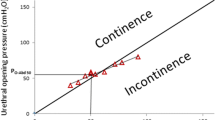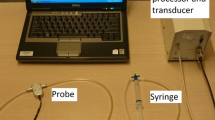Abstract
The aim of the study was to test the reproducibility of a new method of determining cough-induced leak-point pressure (CILPP). A cough-induced increase in intra-abdominal pressure was recorded vaginally in 26 women with stress incontinence and urinary leakage was detected electronically. CILPP determinations and short-term pad tests were carried out on two different occasions. Reproducibility is expressed by a coefficient of repeatability as limits of agreement. These indicate that, for 95% of the cases, a repeat measurement of CILPP will be between 0.72 and 1.28 times the first measurement. The coefficient of variation was 11.2%. There was a moderate inverse correlation between padtest data and CILPP. It was concluded that the new method allows for an accurate determination of CILPP, which represents a quantitative and dynamic assessment of urethral function. The reproducibility of the method appears to be better than that of pad tests and standard urodynamic parameters. The correlation with pad-test data gives support to the validity of the method.
Similar content being viewed by others
References
Abrams P, Blaivas JG, Stanton SL, Andersen JT. The standardisation of terminology of lower urinary tract function.Scand J Urol Nephrol Suppl 1988;114:15–19
Richardson DA. Value of the cough pressure profile in the evaluation of patients with stress incontinence.Am J Obstet Gynecol 1986;155:808–811
Versi E. Discriminant analysis of urethral pressure profilometry data for diagnosis of genuine stress incontinence.Br J Obstet Gynecol 1990;97:251–259.
Scotti RJ, Myers DL. A comparison of the cough stress test and single-channel cystometry with multichannel urodynamic evaluation in genuine stress incontinence.Obstet Gynecol 1993;81:430–433
Enhörning G. Simultaneous recording of intravesical and intraurethral pressure.Acta Chir Scand Suppl 1961;276:1–68
Richardson DA, Ramahi A. Reproducibility of pressure transmission ratios in stress incontinent women.Neurourol Urodyn 1993;12:123–130
Bump RC, Fantl JA, Hurt WG. Dynamic urethral pressure profilometry pressure transmission ratio determinations after continence surgery: understanding the mechanism of success, failure, and complications.Obstet Gynecol 1988;72:870–874.
Rosenzweig BA, Bathia NN, Nelson AL. Dynamic urethral pressure profilometry pressure transmission ratios: what do the numbers really mean?Obstet Gynecol 1991;77:586–590.
Eriksen BC, Hagen B, Eik-Nes SH, Molne K, Miølnerød OK, Romslo I. Long-term effectiveness of the Burch colposuspension in female urinary stress incontinence.Acta Obstet Gynecol Scand 1990;69:45–50
Herbertsson G, Iosif CS. Surgical results and urodynamic studies 10 years after retropubic colpourethrocystopexy.Acta Obstet Gynecol Scand 1993;72:298–301
Lose G, Rosenkilde P, Gammelgaard J, Schroeder T. Padweighing test performed with standardized bladder volume.Urology 1988;XXXII:78–80
Fantl JA, Harkins SW, Wyman JF, Choi SC, Taylor JR. Fluid loss quantitation test in women with urinary incontinence: a testretest analysis.Obstet Gynecol 1987;70:739–743
Thind P, Gerstenberg TC. One-hour ward test vs. 24-hour home pad weighing test in the diagnosis of urinary incontinence.Neurourol Urodyn 1991;10:241–245
Victor A, Larsson G, Åsbrink A-S. A simple patient-administered test for objective quantification of the symptoms of urinary incontinence.Scand J Urol Nephrol 1987;21:277–279
Lose G, Jørgensen L, Thunedborg P. 24-hour home pad weighing test versus 1-hour ward test in the assessment of mild stress incontinence.Acta Obstet Gynecol Scand 1989;68:211–215
McGuire EJ, Woodside JR, Borden TA, Weiss RM. Prognostic value of urodynamic testing in myelodysplastic patients.J Urol 1981;126:205–209
Wan J, McGuire EJ, Bloom DA, Ritchey ML. The treatment of urinary incontinence in children using glutaraldehyde crosslinked collagen.J Urol 1992;148:127–130
McGuire EJ, Fitzpatrick CC, Wan J et al. Clinical assessment of urethral sphincter function.J Urol 1993;150:1452–1454
Richardson DA. Use of vaginal pressure measurements in urodynamic testing.Obstet Gynecol 1985;66:581–584
Plevnik S, Vrtacnik P, Janez J. Detection of fluid entry into the urethra by electric impedence measurement: electric fluid bridge test.Clin Phys Physiol Meas 1983;4:309–313
Mayne CJ, Hilton P. The distal urethral electrical conductance test: standardisation of method and clinical reliability.Neurourol Urodyn 1988;7:55–60
Bland JM, Altman DG. Statistical methods for assessing agreement between two methods of clinical measurement.Lancet 1986;327:307–310
Snedecor GW. Queries.Biometrics 1952;8:85–86
Abraham GE, Swerdloff R, Tulchinsky D, Odell WD. Radioimmunoassay of plasma progesterone.J Clin Endocrinol 1971;32:619–624
Decter RM, Harpster L. Pitfalls in determination of leak point pressure.J Urol 1992;148:588–591
Miklos J, Sze EHM, Karram MM. A critical appraisal of the methods of measuring leak-point pressures in women with stress incontinence.Obstet Gynecol 1995;86:349–352
Bump RC, Elser DM, Theofrastous JP, McClish DK. Valsalva leak point pressures in women with genuine stress incontinence: reproducibility, effect of catheter caliber, and correlations with other measures of urethral resistance.Am J Obstet Gynecol 1995;173:551–557
Bump RC, W E Copeland J, Hurt WG, Fantl JA. Dynamic urethral pressure/profilometry pressure transmission ratio determinations in stress-incontinent and stress-continent subjects.Am J Obstet Gynecol 1988;159:749–754
Hilton P, Stanton SL. Urethral pressure measurements by microtransducer: the results in symptom-free women and in those with genuine stress incontinence.Br J Obstet Gynaecol 1983;90:919–933
Swift SE, Ostergard DR. A comparison of stress leak-point pressure and maximal urethral closure pressure in patients with genuine stress incontinence.Obstet Gynecol 1995;85:704–708
Song JT, Rozanski TA, Belville WD. Stress leak point pressure: a simple and reproducible method utilizing a fiberoptic microtransducer.Urology 1995;46:81–84
Author information
Authors and Affiliations
Additional information
Editorial Comment: As healthcare providers for women with urinary incontinence, we are constantly seeking new and better ways to evaluate patients and optimize the outcome of their care. Leak-point pressure measurement has recently been presented as a less cumbersome, less costly and less invasive technique. Its proponents claim it is more physiologic and incremental, thus allowing us to assess improvement with therapy as well as to diagnose incontinence. However, detractors rightfully claim that its use is not supported by any outcome-based data, and that there is little known about many confounding variables, including position, fluid density, loss detection, number and size of catheters, abdominal versus vesical pressure etc. The reproducibility of the technique also needs to be addressed. The leak-point pressure may prove to be a useful addition to the armamentarium of the urodynamic unit. Work like this is a welcome addition to our knowledge base but represents a fraction of what is necessary before leak-point pressure can be widely embraced as a clinical tool.
Rights and permissions
About this article
Cite this article
Siltberg, H., Larsson, G. & Victor, A. Reproducibility of a new method to determine cough-induced leak-point pressure in women with stress urinary incontinence. Int Urogynecol J 7, 13–19 (1996). https://doi.org/10.1007/BF01895097
Issue Date:
DOI: https://doi.org/10.1007/BF01895097




